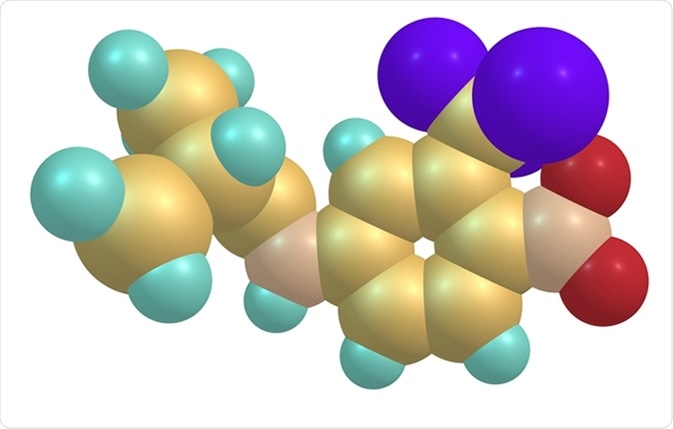Antiandrogens are a group of medications which bind to intracellular androgen receptors (AR) to prevent androgen effects on organs such as the testes, the hair follicles, the hypothalamus, pituitary, ovaries and the prostate gland, which are targets of endogenous androgens. They are used to treat a variety of clinical conditions which are characterized by hyperandrogenism, such as acne, hirsutism, and prostate cancer.
Chemical classification
The antiandrogens are grouped as:
- Steroidal: cyproterone acetate, progesterone analogs such as mifepristone or RU-486, and megestrol acetate, and spironolactone, which is a mineralocorticoid analog
- Nonsteroidal: flutamide, nilutamide, bicalutamide
The steroidal antiandrogens bind not only the AR but also other steroid receptors, such as those for glucocorticoids and progestin, leading to nonspecific effects. Cyproterone has proven itself in many clinical trials to be useful in prostate cancer, but is not FDA-approved due to its hepatotoxicity and partial agonist activity.

Flutamide is a nonsteroidal antiandrogen NSAA used primarily to treat prostate cancer. It acts as a selective antagonist of the androgen receptor. Image Credit: Igor Petrushenko / Shutterstock
The nonsteroidal drugs were developed in the 1970s, and act only upon the AR. They are therefore far more specific in their antiandrogenic effects. This means better clinical tolerability with less bone loss, anemia and impotence, but greater gynecomastia. All of them can cause alcohol intolerance, diarrhea and liver toxicity, while nilutamide may affect color vision and light adaptation difficulties. They are associated with better survival and longer durations without disease progression, as well as improved clinical response, following orchiectomy, compared to the surgical procedure alone.
Flutamide is the drug which has been around the longest in this category, and functions as a prodrug, which is metabolized to an active congener. Nilutamide and bicalutamide need to be activated metabolically. These are used along with chemical or surgical castration to remove all chances of exposure of prostate cancer cells to androgens from the adrenal gland, rather than removing the adrenal gland which could result in fatal or debilitating outcomes, such as hypoadrenalism. Nilutamide has a longer duration of action which allows single daily doses to be prescribed. Bicalutamide is twice as avid for the AR and has a half-life of one week, which is the longest in this category of drugs, besides causing less liver damage. It is used along with long-acting gonadotropin antagonists such as leuprolide as an effective and less toxic alternative to flutamide, and has now become the most commonly used, with a single daily dose protocol.
Mechanism of Action
Antiandrogens are molecules that compete with androgens to bind in the ligand binding site of the AR. Their binding, however, leads to unfavorable conformational changes, which downregulate transcription and so prevent the androgenic effects of normal binding.
Inhibitors of Androgen Synthesis
Nonspecific inhibitors
While other compounds also suppress androgen synthesis, such as glucocorticoids, aminoglutethimide and ketoconazole, these are not considered antiandrogens as their mechanism of action does not involve the AR, but rather various routes of synthesis. Glucocorticoids such as prednisone, exert a negative feedback mechanism on central stimulation of steroid production, thus preventing adrenal androgen production. Aminoglutethimide blocks the cytochrome P450 enzymes, which are required for adrenal steroid synthesis. Ketoconazole is an imidazole, which inhibits these enzymes in a nonspecific manner. These drugs have significant toxicities such as tiredness, hepatotoxicity, and nerve toxicity, as well as major drug-drug interactions because of their inhibition of a broad spectrum of enzymes, which metabolize other medications.
CYP17A inhibitors
The CYP17A enzyme family is involved in the biosynthesis of androgens in the testes and adrenals, culminating in the weak androgens dehydroepiandrosterone (DHEA) and androstenedione, that further undergo metabolism in peripheral tissues (and in prostate cancer cells) to form potent androgens, such as testosterone and its active metabolite dihydotestosterone (DHT). One promising drug in this family is abiraterone acetate, which shows good activity against androgens and especially lowers testosterone levels, however, disease progression has not been affected.
5α reductase inhibitors
Since the most potent androgen, DHT, is synthesized from testosterone in peripheral tissues by 5α reductase, any therapy that inhibits this enzyme would be potentially useful as an antiandrogen. This includes finasteride, which is used in the management of benign prostatic hyperplasia and hirsutism, and dutasteride, a more recent molecule which is under clinical testing for prostate cancer.
Uses
Cyproterone acetate, spironolactone, flutamide and finasteride have been used in the treatment of hirsutism.
Prostate cancer: Most clinical applications have made use of flutamide, mostly for prostate cancer, which therefore has the best documented clinical history. It is capable of producing remission in patients with prostate cancer, and alleviates symptoms in patients with acne and hirsutism.
Nilutamide has also been studied in many trials and is now recommended for use as an adjuvant to castration in the treatment of metastatic prostate cancer, with its use beginning immediately after orchiectomy. Bicalutamide is the newest in this category and is also used in the same way. With an impressive efficacy and safety profile. Unlike flutamide, these have not been largely used to treat nonmalignant conditions caused by excessive androgen levels.
Newer Antiandrogens
Novel agents are being designed to be bulkier because this is suggested to counteract AR binding by steric hindrance. Such compounds have been made to possess greater AR affinity, which are capable of potent downregulation of transcriptional pathways. Steric hindrance has also been introduced by linking AR agonists to another molecule which binds FK-506, these being binding proteins that are present in all cells. A third route is to use compounds that inhibit nuclear transcription following AR binding by disrupting intramolecular communication. Two novel antiandrogens which are currently being actively tested are BMS-641988 and MDV310.
Further Reading